Factors Influencing Dental Care Utilization in India Explained
Introduction
Just like small daily habits can transform your life, consistent dental habits can create a lifetime of confident, healthy smiles. Learn more in The Habit Method.
Oral health is a vital yet often overlooked component of general health. In India, with its diverse population and healthcare challenges, understanding dental care utilization patterns is key to improving nationwide oral health outcomes. Despite having one of the largest networks of dental schools in the world, many Indians still lack timely access to professional dental treatment. By exploring the factors that influence how individuals seek and use dental services, policymakers and providers can find effective solutions to close the gap.
Current Status of Dental Care in India
The burden of oral disease in India remains high. According to national health reports, more than 60% of adults live with untreated dental caries, and around 50% of children experience cavities before adolescence Ministry of Health & Family Welfare, Government of India. Periodontal disease is equally widespread, affecting almost 70% of adults over the age of 35.
Urban vs Rural Divide:
- In urban centers, private dental clinics are widely available, but services are often expensive.
- In rural areas, limited availability of dentists and poorly equipped government facilities pose significant challenges.
- India has approximately one dentist per 10,000 people in urban areas, compared to just one per 150,000 in rural regions World Health Organization.
Key Factors Influencing Dental Care Utilization in India
Socioeconomic Status and Affordability
Affordability remains one of the strongest predictors of dental visits. The cost of dental treatment in India is entirely out-of-pocket for most people since health insurance rarely covers oral care. For low-income families, even preventive visits seem like a luxury. Many patients delay treatment until pain becomes unbearable, leading to more invasive and costly procedures later.
Education and Awareness
Oral health literacy significantly shapes dental service utilization. A study published in BMC Health Services Research highlights that lack of preventive dental knowledge results in higher treatment needs later BMC Health Services Research, 2025. School-based dental education in urban areas has improved awareness, but rural populations often do not receive structured guidance on brushing, diet, and preventive care. This gap directly affects utilization of regular check-ups and preventive dentistry.
Geographic Location and Accessibility
India’s rural population, nearly 65% of the total, faces an acute shortage of dental resources. Travel distance, lack of reliable transport, and limited clinic availability are major barriers. Even when rural clinics are available, they may lack modern equipment or specialist care, forcing patients to travel long distances for treatment.
Cultural Beliefs and Perceptions
Cultural attitudes also influence how dental care is perceived. Many individuals rely on traditional home remedies or ignore dental problems until severe, believing tooth loss is a natural part of aging. Misconceptions such as avoiding dental treatment during pregnancy or relying solely on herbal mouth rinses continue to prevent utilization of modern dental services.
Barriers to Dental Care in India
- Limited dental professionals: Although India produces thousands of new dentists each year, the majority practice in urban and semi-urban areas, leaving rural regions underserved.
- High out-of-pocket expenses: Dental treatment costs can be prohibitive for middle- and low-income households.
- Inadequate dental insurance: Most insurance products exclude oral health, leading to poor financial protection.
- Lack of preventive culture: Routine dental check-ups are not yet a part of mainstream healthcare behavior.
Strategies to Improve Dental Care Utilization
Preventive Care and Oral Health Campaigns
Government-led oral health campaigns have proven effective in increasing awareness. School programs that emphasize twice-daily brushing, reducing sugary snacks, and annual dental check-ups are crucial preventive strategies. Community models, such as mobile dental van programs, are bridging some gaps in accessibility.
Government Policies and Public Health Interventions
Policy changes are necessary to integrate dental care into primary healthcare. National oral health programs must prioritize affordability through subsidies, tax incentives for rural clinics, and inclusion of key dental treatments under public health schemes. A stronger focus on public health dentistry can create community-wide improvements.
Strengthening Dental Workforce and Infrastructure
Expanding the number of dental professionals in rural areas is essential. Incentives for recent graduates to practice in underserved regions, alongside public-private partnerships, can help balance workforce distribution. Strengthening rural dental infrastructure with equipment and digital support will reduce the disparity between rural and urban areas.
Role of Technology and Digital Health in Dental Care
Digital technology is emerging as a game-changer in oral healthcare delivery. Teledentistry in India enables patients in remote areas to consult with specialists virtually, reducing the need for travel and cutting costs. Mobile applications promoting oral hygiene reminders, symptom checkers, and educational videos are becoming valuable tools for patient awareness. These innovations hold potential to bridge the gap in access and awareness while keeping care affordable.
Frequently Asked Questions
- Why do so few people in India visit the dentist regularly?
Factors such as cost, lack of awareness, rural accessibility issues, and cultural perceptions discourage routine dental visits. - Is dental treatment in India affordable for most people?
Unfortunately, most dental treatments are paid out-of-pocket, and affordability remains a major challenge for middle and low-income families. - How does oral health awareness differ between rural and urban India?
Urban populations generally have better access to dental education initiatives, while rural communities often lack structured oral health awareness programs. - What role does teledentistry play in India?
Teledentistry helps patients in remote areas receive consultations, saving time and cost, especially for follow-ups and preventive guidance. - What can individuals do to improve their own oral health?
Brushing twice daily with fluoride toothpaste, reducing sugar intake, and visiting the dentist at least once a year can significantly improve oral health outcomes.
Conclusion
The utilization of dental care in India is shaped by socioeconomic, cultural, geographic, and policy-level factors. Improving affordability, ensuring accessibility in rural areas, enhancing awareness through education, and leveraging technology can all play a role in improving oral health outcomes. Collective efforts from policymakers, healthcare providers, and the public are essential to creating an equitable oral healthcare system. Remember, building healthier smiles begins with small consistent actions—just like in life. Learn more in The Habit Method.
Post Disclaimer
DentalUp is for educational purposes only and cannot accept personal dental information such as x-rays, photos, or treatment details. See full disclaimer here.





